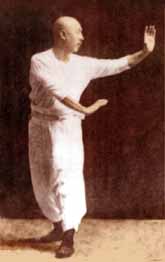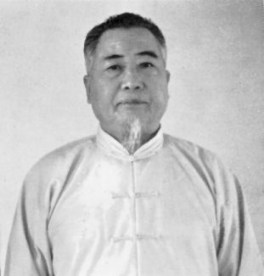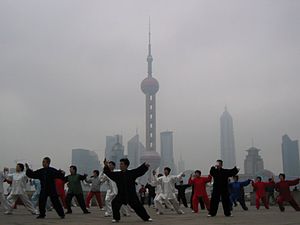
Neijia is the collective name for the internal Chinese martial arts. It relates to those martial arts occupied with spiritual, mental or qi-related aspects, as opposed to an "external" approach focused on physiological aspects. The distinction dates to the 17th century, but its modern application is due to publications by Sun Lutang, dating to the period of 1915 to 1928. Neijin is developed by using neigong or "internal changes", contrasted with waigong or "external exercises".

Baguazhang is one of the three main Chinese martial arts of the Wudang school, the other two being tai chi and xingyiquan. It is more broadly grouped as an internal practice. Baguazhang literally means "eight trigram palm", referring to the bagua "trigrams" of the I Ching, one of the canons of Taoism.

Shaolin kung fu, also called Shaolin Wushu, or Shaolin quan, is one of the oldest, largest, and most famous styles of wushu, or kung fu of Chan Buddhism. It combines Chan philosophy and martial arts. It was developed in the Shaolin Temple in Henan province, Greater China during its 1500-year history. Popular sayings in Chinese folklore related to this practice include "All martial arts under heaven originated from Shaolin" and "Shaolin kung fu is the best under heaven," indicating the influence of Shaolin kung fu among martial arts. The name Shaolin is also used as a brand for the so-called external styles of kung fu. Many styles in southern and northern China use the name Shaolin.

Hung Ga (洪家), Hung Kuen (洪拳), or Hung Ga Kuen (洪家拳) is a southern Chinese martial art belonging to the southern Shaolin styles. The hallmarks of Hung Ga are strong stances, notably the horse stance, or "si ping ma" (四平馬), and strong hand techniques, notably the bridge hand and the versatile tiger claw. Traditionally, students spent anywhere from several months to three years in stance training, often sitting only in horse stance from half an hour to several hours at a time, before learning any forms. Each form could then take a year or so to learn, with weapons learned last. In current times, this mode of instruction is generally considered impractical for students, who have other concerns beyond practicing kung fu. However, some instructors still follow traditional guidelines and make stance training the majority of their beginner training. Hung Ga is sometimes mischaracterized as solely external—that is, reliant on brute physical force rather than the cultivation of qi—even though the student advances progressively toward an internal focus.

Chinese martial arts, commonly referred to with umbrella terms kung fu, kuoshu or wushu, are multiple fighting styles that have developed over the centuries in Greater China. These fighting styles are often classified according to common traits, identified as "families" of martial arts. Examples of such traits include Shaolinquan (少林拳) physical exercises involving All Other Animals (五形) mimicry or training methods inspired by Old Chinese philosophies, religions and legends. Styles that focus on qi manipulation are called internal, while others that concentrate on improving muscle and cardiovascular fitness are called external. Geographical associations, as in northern and southern, is another popular classification method.

Mizongyi is a style of Chinese martial art based on deception and mobility.

Liuhebafa quan is an internal Chinese martial art. It has been called "xinyi liuhebafa" (心意六合八法拳) and is also referred to as "water boxing" due to its principles.

In Chinese martial arts, there are fighting styles that are modeled after animals.

Wushu, or kung fu, is a competitive Chinese martial art. It integrates concepts and forms from various traditional and modern Chinese martial arts, including Shaolin kung fu, tai chi, and Wudangquan. "Wushu" is the Chinese term for "martial arts", reflecting the art's goal as a compilation and standardization of various styles.

Kenji (拳児) is a manga series written by Ryuchi Matsuda and illustrated by Yoshihide Fujiwara. The series follows Kenji Goh, a practitioner of the Chinese martial art Bajiquan.

Huaquan is a Chinese martial art in the changquan family. It is believed to have originated during the Liu Song dynasty near Mount Hua in Shaanxi Province.

Hung I-Hsiang or Hong Yixiang (1925–1993) was a Taiwanese martial artist who specialized in the internal Chinese styles of xingyiquan, baguazhang, and taijiquan.

Sam Masich is a tai chi instructor, performing songwriter and filmmaker residing in Vancouver, British Columbia, Canada and Berlin, Germany.

Chang Dsu Yao was a teacher of the martial arts Meihuaquan and tai chi.

Choy Gar, also Caijia Quan, is a Chinese martial art deriving its name from the Cantonese-born founder, Choy Gau Lee (蔡九儀), and is one of the five main family styles of Kung Fu in Southern China. It was taught to him by a monk named Yi Guan. This style, founded in the 17th century, is a combination of rat and snake styles emphasizing on swift footwork and rapid strikes.

Wudangquan is a class of Chinese martial arts. In contemporary China, Chinese martial arts styles are generally classified into two major groups: Wudang (Wutang), named after the Wudang Mountains; and Shaolin, named after the Shaolin Monastery. Whereas Shaolin includes many martial art styles, Wudangquan includes only a few arts that use the focused mind to control the body. This typically encompasses tai chi, xingyiquan and baguazhang, but must also include bajiquan and Wudang Sword. Although the name Wudang simply distinguishes the skills, theories and applications of the internal arts from those of the Shaolin styles, it misleadingly suggests these arts originated at the Wudang Mountains. The name Wudang comes from a popular Chinese legend that incorrectly purports the genesis of tai chi and Wudang Sword by an immortal, Taoist hermit named Zhang Sanfeng who lived in the monasteries of Wudang Mountain. Wudang quan is often used synonymously with Neijia, but Neijia is a broader term that also encompasses Aikido and Qigong, which are not Wudang quan.

Xingyiquan, or Xingyi, is a style of internal Chinese martial arts.

Snake kung fu is a Shaolin boxing style, one of several Chinese martial arts known as "snake boxing" or "fanged snake style" that imitate the movements of snakes. Proponents claim that adopting the fluidity of snakes allows them to entwine with their opponents in defense and strike them from angles they would not expect in offense. Snake style is said to especially lend itself to applications with the Chinese straight sword. The snake is also one of the animals imitated in Yang-style tai chi, Baguazhang and Xingyiquan. The sinuous, fluid motion of the snake lends itself to the practical theory that underlies the "soft" martial arts.
Chan Kowk-wai was born on 3 April 1936, in Taishan in the province of Guangdong, China. He introduced traditional Shaolin kung fu to Brazil through the China-Brazil Kung Fu Academy. His disciples have spread as far as the USA, Canada, Spain, Argentina and the Czech Republic.













